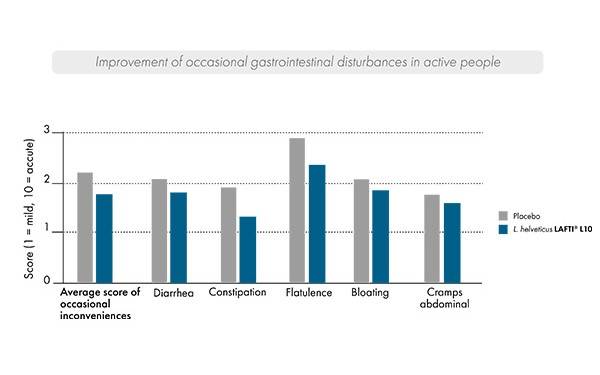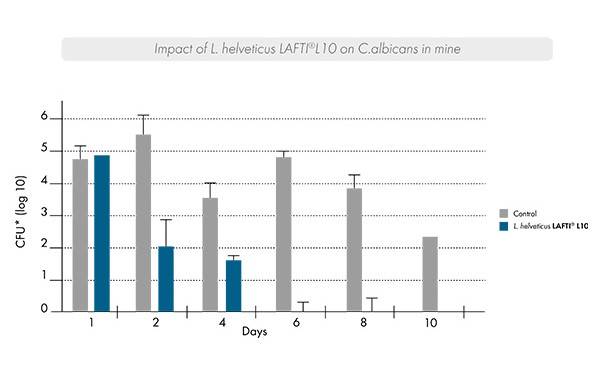
LACTOBACILLUS HELVETICUS LAFTI® L10 : A MICROBIOTA STRAIN WITH PROVEN EFFICACY ON INTESTINAL COMFORT AND AGAINST CANDIDIASIS
Lactobacillus helveticus, an isolated Gram+ rod-shaped bacterium, is a lactic acid bacterium widely used in the manufacture of fermented dairy products. It is notably present in Swiss Emmental cheese, hence its Latin name « helveticus ». In addition to their use in the manufacture of certain cheeses, some strains of L. helveticus also have beneficial properties for intestinal health1 and in cases of candidiasis2.
The registered strain of L. helveticus LAFTI® L10 is resistant to gastric acidity and bile3, and is characterised by strong adhesion to the intestinal epithelium4, making it the strain of choice for improving intestinal comfort and combating candidiasis.
In vivo gastrointestinal models have shown the ability of L. helveticus LAFTI® L10 to:
- Support natural defences by competing with pathogens such as Listeria monocytogenes, E. coli and Candida albicans 5
- Act in synergy with prebiotic fibres: FOS and inulin 6
- Modulate the pro-inflammatory response: decrease in colonic myeloperoxidase (MPO) activity, decrease in the production of the inflammatory mediator LTB4, increase in glutathione levels and support antioxidant metabolism 3.
In a clinical study of 60 adults, L. helveticus LAFTI® L10 significantly reduced occasional gastrointestinal upset 7.

In addition, a mechanistic study showed that L. helveticus LAFTI® L10 prevented colonisation by C. albicans, the main pathogen responsible for vaginal bacteriosis2.


*CFU: Colony Forming Units
(1) Taverniti V., Guglielmetti S. (2012) Health-Promoting Properties of Lactobacillus helveticus. Frontiers in Microbiology. (3):392
(2) Elahi, S., G. Pang, R. Ashman, et R. Clancy. « Enhanced Clearance of Candida Albicans from the Oral Cavities of Mice Following Oral Administration of Lactobacillus Acidophilus ». Clinical & Experimental Immunology 141, no 1 (2005): 29 36. https://doi.org/10.1111/j.1365-2249.2005.02811.x.
(3) Welin A. et al.(2005).“Survival of L. acidophilus and L. casei in the human GI tract perceived effects on health” Nutrafoods (4): 2-3.Pang, G. (2005). A comparative study of probiotic bacterial strains in vitro and in vivo.
(4) Lallemand internal report
(5) Mahoney, M. and A. Henriksson (2003). “The effect of processed meat and meat starter cultures on gastrointestinal colonization and virulence of Listeria monocytogenes in mice.” Int J Food Microbiol 84(3): 255-261.
(6) Su, P., et al. (2007).”Selected prebiotics support the growth of probiotic monoculturesin vitro.” Anaerobe 13(3-4): 134-139 Peran, L., et al. (2007). “A comparative study of the preventative effects exerted by three probiotics, Bifdobacterium lactis, a.Lactobacillus casei and Lactobacillus acidophilus, in the TNBS model of rat colitis.” J Appl Microbiol 103(4): 836-844
(7) Paturi, G., et al. (2007). “Immune enhancing effects of Lactobacillus acidophilus LAFTI® L10 and Lactobacillus paracasei LAFTI® L26 in mice.” Int J Food Microbiol 115(1): 115-118










